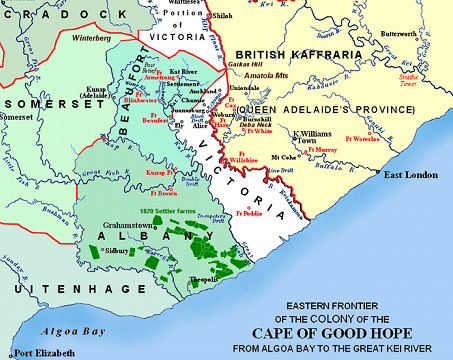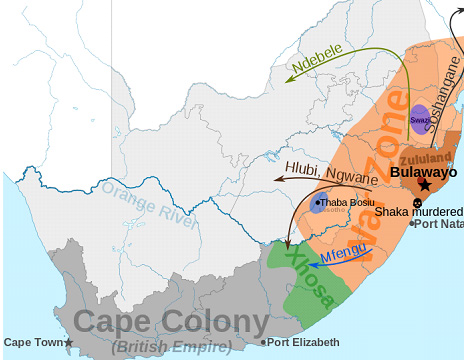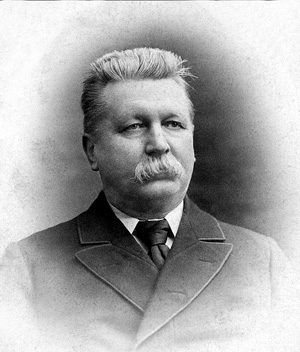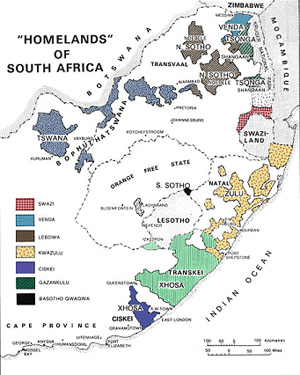The Empty or Vacant Land Theory is a theory that was propagated by European settlers in nineteenth-century South Africa to support their claims to land. Today this theory is described as a myth, the Empty Land Myth because there is no historical or archaeological evidence to support this theory. Despite evidence to the contrary a number of parties in South Africa, particularly right-wing nationalists of European descent, maintain that the theory still holds true in order to support their claims to land-ownership in the country.
With his book The Past and Future of the Kaffir Races (1866), W. C. Holden was one of the early writers on South African history to publish a book that used the theory of empty land as an explanation for landownership in South Africa. In order to legitimise European settlement in South Africa Holden argued Europeans and the Bantu tribes had entered South Africa at roughly the same time and that up until that point South Africa had mostly been an ‘empty land’. The theory outlined by Holden claimed that the Bantu had begun to migrate southwards from present-day Zimbabwe at the same time as the Europeans had begun to migrate northwards from the Cape settlement, with the two movements finally meeting in the Zuurveld region between the Sundays River and the Great Fish River. This, the theory claimed, gave equal right to the land to whoever could take ownership of it, with force, and maintain that ownership. There were, therefore, no ‘original’ inhabitants with an ‘original’ right to the land, only two migrating groups who had equal claim to it.
Although Holden was the first to publish the theory of empty land in a book, the theory itself had been circulating in the colony for a long time, with many colonists claiming that they had as great a right to the land as the newly arrived Bantu. Myths of empty and vacant land were common currency by the mid-1840s.
The Graham's Town Journal argued in 1838, for example, that the Xhosa had been “the usurpers of the whole of the territory between the Kye and the Fish River” and that the British had more of a right to the land than a people who "had gained a footing in it by treachery and violence". The British were convinced that the Xhosa had only recently entered into the region and had taken the land by force from the Khoikhoi, and so the British had the right to take it by force from the Xhosa. The British based this belief on two observations they had made. The first was that at the time when the British and the Dutch were approaching the frontier there had been a few isolated incidents of Xhosa clans who were fleeing internal conflicts moving into Khoikhoi territory, particularly in the Zuurveld region such as when the Khoikhoi Queen Hoho and her clan had been defeated in a battle in the Queenstown area in the 1770s by a group of Xhosa fleeing Rarabe.
 The eastern frontier of the Cape Colony, a point of convergence between the Xhosa and the British settlers. Source
The eastern frontier of the Cape Colony, a point of convergence between the Xhosa and the British settlers. Source
Despite the fact that these were very few and isolated incidents, the British and the Dutch jumped on them and vociferously used them to make a claim that the Xhosa had clearly taken all the land between the two rivers by the violent expulsion of the Khoikhoi. That the Xhosa used Khoikhoi place names for regions and geographic features was also pounced upon by the British as an unequivocal indication that they must have taken the land by force in recent times. Contemporary historical work shows that there was a long period of intermingling and integration between the western Xhosa and eastern Khoi, giving rise to the Khoi place names in Xhosa territory and the permeable nature of the boundaries between the two groups.
Much of the idea of the 'vacant land' myth in African colonial history rests on a White misunderstanding - however wilful - of African sovereignty and land use. Most of the Bantu and Khoikhoi used the land in a rotation, often leaving large sections of land fallow while they cultivated another region or moved their herds to greener pastures. As pastoralists they would migrate through various grazing-grounds, thereby appearing to leave a grazing ground, not in current use 'empty'.
An alternative form of the same myth was built around the British and Afrikaner understandings of the Mfecane. The Mfecane, translated roughly as ‘the crushing’, was a time of great political upheaval in the Zulu Kingdom in the first half of the nineteenth century. Both the British and the Afrikaner used the Mfecane to make the argument that the land they were occupying had been ‘deserted’.
 A map of the rise of the Zulu Empire under Shaka during the Mfecane. Source
A map of the rise of the Zulu Empire under Shaka during the Mfecane. Source
In the 1850s, when the British began to consolidate the colony of Natal in what is today Kwa-Zulu Natal, they claimed that only 4 000 to 5 000 inhabitants of the land were actually 'indigenous' inhabitants who had a right to that land. The rest of the Zulus living in the area, or moving into it in large droves, were "interlopers", either refugees fleeing the despotic rule of Shaka or Zulus returning to their old homelands after Shaka's Mfecane, which had begun in around 1815 and only came to an end around 1840. Although the latter were understood by the British to be returning to their own lands, the British claimed that "Kafirs have little attachment to any particular locality", implying that the Zulu's would not mind moving to any land and therefore had no particular claim to the land the British had taken. In light of this the British claimed that much of Natal had been 'vacant' land at the time of colonisation and therefore the British had a right to claim it. For the most part they respected the land claims of the Boers who had entered the region just before British colonisation (although these Boers had to submit to British rule), but they used the narrative of refugees and the claim that Zulus were not attached to their land to argue that up to 40 000 Zulus should be removed from the Natal Colony.
When the Afrikaner Trek Boers reached the Vaal Highveld after their incursion across South Africa from the Cape, they made a similar argument to the British in order to justify their claims to the land in the Highveld. They claimed that upon their arrival the region was almost devoid of any African inhabitants because the thinking went, they had all fled in the face of the Mfecane. The Boers believed that the land was deserted and abandoned and therefore theirs for the taking. Part of the Afrikaner Boers mythology also claimed that the Boers had rescued the few scattered tribes of the region by giving them protection against the forces of Shaka. This myth, of a Vaal region that was deserted by the Bantu, is one that still has a number of proponents in some Afrikaner communities.
 George M. Theal, 1890s Source
George M. Theal, 1890s Source
In the 1890s, the renowned South African historian George McCall Theal, considered to be the grandfather of South African history, once again gave credence to a theory that the Bantu had migrated into South Africa at the same time as the Europeans. In his voluminous works on history, based on an analysis of place names and supposed archaeological evidence, Theal claimed to give scientific evidence that the Bantu people had only begun to cross the Limpopo river at roughly the same time as when Europeans began to settle at the Cape, leaving the rest of South Africa a veritable ‘vacant land’. Theal’s work reaffirmed the myth of the vacant land in South African historiography and in popular memory. By the turn of the nineteenth century the idea that South Africa had been populated by Europeans and Bantu at the same time and that large tracts of Bantu land had been deserted, left vacant, during the Mfecane, became accepted ‘fact’ in South African society.
The myth of the empty land became particularly destructive in the hands of the Apartheid Government. The Apartheid Government used this myth as a justification for their construction of the homelands. Although the homelands in South Africa housed 70% of the population, they only comprised of 13% of the total landmass. The Apartheid Government justified this incredibly unequal distribution of land by claiming that the land in White hands was historically 'empty land', land that had belonged to nobody and therefore could not form part of a homeland. The homelands, they argued, were made up of all the land that had been occupied by the Bantu people, but the rest of the country had had no indigenous inhabitants and therefore legitimately belonged to the White inhabitants who had claimed it first.
 A map of the ‘Homelands’ under the Apartheid Regime Source
A map of the ‘Homelands’ under the Apartheid Regime Source
In the 1980s revisionist and liberal historians and archaeologists began to argue against the theory of empty land. Using new archaeological evidence they were able to show the presence of Bantu like people in the eastern half of South Africa since around 300 AD. They were also able to show that even though there had indeed been a large Bantu migration into the region at a later date, that date was somewhere around the 12th century AD, rather than in the seventeenth century as had been previously argued. Historians began to unpack the ways in which the myth of the vacant land had come into being and were able to show how its emergence coincided with the increasing clashes for land between the Bantu and the British and Afrikaners.
Historians and activists alike also pointed to a glaring omission on the theory of the empty land – the absolute silence on the existence of the KhoiSan (KhoiKhoi and San/Bushman) populations of Southern Africa who roamed much of the south western region of the country. KhoiSan peoples had been living in the region for millennia when the Dutch first arrived. Their plight, and their undeniable claims to the land gets no reference in the 'empty land theory'.
Myths form an integral part of any peoples understanding of self and their place in the world, and are central to justifying the current distribution of power and resources. The myth of the empty land into which both Bantu and European peoples migrated at the same time, but from opposite directions, arose after the most violent clashes had occurred between the Bantus and the Europeans. Afrikaner nationalists, disillusioned with the British government at the Cape, had migrated out of the Colony and into the east of the country during the Great Trek. The British had encountered vast numbers of Xhosa at the Fish River and had been continuously engaging in battles and treaties with them. By the 1860s, when Woulden propagated his theory, this turbulent period had resulted in large swathes of South African land falling under the dominion of either the Afrikaner Republics or British colonial territory. Both these groups were in a position where a foundation myth which gave them the legitimate right of the land they had claimed was central to their own sense of nationhood.
The Myth of the empty land had become a central tenet of both British and Afrikaner identity in nineteenth-century South Africa and had been used as a justification for the capture and settlement of Bantu land. The Apartheid Government had transformed the myth to serve its own ends. They used it to support the Homelands Act and to confine the Bantu people to particular localities, arguing that the rest of the country had been ‘empty’ and therefore could not form part of their Homelands. Since the 1980s however, evidence has shown that the myth of the empty land simply cannot be sustained. Rather than being a historical fact, it is a convenient fiction that has served as a political tool.
